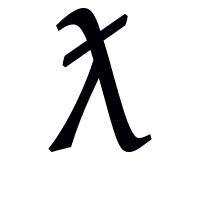Barred lambda
| Barred lambda | |
|---|---|
| ƛ | |
 | |
| Usage | |
| Writing system | Latin script |
| Type | alphabetic |
| Language of origin | Americanist phonetic notation |
| Sound values |
|
| In Unicode | U+A7DC, U+019B |
| History | |
| Development | |
| Other | |
The barred lambda ( ƛ) (U+A7DC LATIN CAPITAL LETTER LAMBDA WITH STROKE, U+019B ƛ LATIN SMALL LETTER LAMBDA WITH STROKE), is a modified letter of the Greek alphabet, commonly encountered in North American linguistics. It is used by the Salishan and Wakashan languages in Canada.[1] It is also used in Americanist phonetic notation, where it is also known as running man,[2] to transcribe [t͡ɬ]. In physics, it is used to represent the angular wavelength, i.e. the wavelength (λ) divided by 2π (τ), which corresponds to the length taken up by one radian of the wave.
It was first used in a phonetics context in American Anthropologist in 1934:
λ for [dl] has been used in Eskimo by Jenness ... ƛ for [tł] is an innovation formed from λ as ł from l.[3]
It is also used for the affricate [t͡ɬ] in transcribing the Sahaptin language, e.g., iƛúpna ‘he jumped’, and it is commonly used for the same purpose in several languages of the Caucasus. In addition, its counterpart with a combining comma above right (U+0315), ƛ̓, is used for many of the Salish languages, such as Klallam, for an ejective lateral affricate.
Encodings
| Preview | | ƛ | ||
|---|---|---|---|---|
| Unicode name | LATIN CAPITAL LETTER LAMBDA WITH STROKE | LATIN SMALL LETTER LAMBDA WITH STROKE | ||
| Encodings | decimal | hex | dec | hex |
| Unicode | 42972 | U+A7DC | 411 | U+019B |
| UTF-8 | 234 159 156 | EA 9F 9C | 198 155 | C6 9B |
| Numeric character reference | Ƛ |
Ƛ |
ƛ |
ƛ |
References
- ^ Humchitt, Robyn; Jacquerye, Denis; King, Kevin (2023-07-17). "L2/23-191: Proposal to Encode 3 Additional Latin Characters for Wakashan and Salishan Languages to the Unicode Standard" (PDF).
- ^ [1] (strictly speaking, this refers to the glottalized version, [t͡ɬʼ])
- ^ Herzog, George; Newman, Stanley S.; Sapir, Edward; Swadesh, Mary Haas; Swadesh, Morris; Voegelin, Charles F. (Oct–Dec 1934). "Some orthographic recommendations". American Anthropologist. 36 (4): 629–631. doi:10.1525/aa.1934.36.4.02a00300.


